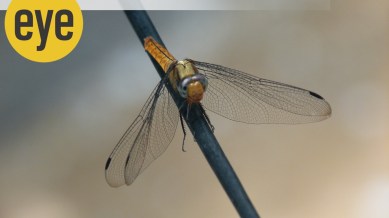The secret life of dragonflies: Underwater predators with jet-powered butts and catapult jaws
Dragonflies spend 90 per cent of their lives as ‘nymphs’, living at the bottom of murky ponds and looking like ghouls that terrify small fish and tadpoles

With their glistening cellophane wings, enormous jewel eyes, incredible flying and hunting skills and beautifully stained wings, dragonflies are a lot of people’s favourite insects. What is less known, is their dark and astonishing history – because for 90 per cent of their lives – perhaps two years or more – dragonflies (or properly dragonfly ‘nymphs’) live at the bottom of murky ponds, looking like ghouls that terrify small fish and tadpoles. And from both the front and rear ends, these creatures are marvels of natural engineering.
Up front, beneath their huge gargoyle eyes, lies a lower lip from hell – called the labium or mask – containing the insect’s main armament. When a potential meal swims by, the labium kind of splits in half and shoots out, from the face, from either side, grabbing the victim in the wink of an eye. The ends of the labium, which are ejectable, have four moving parts: the pre-mentum, the post-mentum and two labial palps at the ends, which can be spade-shaped or tipped with sharp pincers – depending on the species. The spade-shaped ones extend less than the latter – these larvae prefer smaller prey which they can easily encompass when they swim close by.
The longer pincer-clad larvae go for larger victims like tadpoles and small fish, which are stabbed and drawn back into the insect’s maw. The labium then folds up under the mouth and the palps are used for chewing. The most complex part of the operation is the mechanical catapult-like mechanism, which makes the mask shoot out quicker than the eye can see: like all catapults, energy is first drawn in and stored by muscles, and when ready to fire, is triggered off by a release mechanism causing it to shoot out towards the prey. It kind of reminded me of the ‘catapult pellet guns’ I used to fashion out of matchboxes held together by rubber bands, where you stretched a rubber band along the top of the ‘barrel’ of the gun, held it in place with a pin tacked to the gun ‘butt’ and then with a push of the triggering matchbox (where the magazine of a handgun would be), slipped the stretched rubber band over its ‘locking mechanism’, releasing the pellet at high speed. The larvae’s catapult is a lot more complex but works on the same principle.
Their butts are also heavily engineered. Dragonfly nymphs have rectal gills and breathe in a process called rectal ventilation or butt breathing. They suck in oxygenated water through their butt holes, it washes over the gills that absorb the oxygen. The buttholes are also used for jet propulsion – when the nymph needs a quick getaway. Water is drawn in, the anus is sealed, powerful abdomen muscles build up pressure inside the chamber, the anal valve opens suddenly and the nymph shoots forwards. The valve itself is highly complex. It’s not the sphincter-like apparatus one would expect, opening up all at once but is rather like our own tri-leaflet heart valves. When the valve is opened and a jet of water shoots out, it tends to draw in water and particles towards it from all directions.
But when only, say, one of the leaflets open, they direct the flow of water at an angle, enabling fresh water to enter the chamber at the same time. In other words, the nymph can breathe in and out simultaneously. Our own valves, which cannot open separately, are unable to do this, directing the flow of blood in only one direction and this has caused issues in patients requiring valve replacement, where such a singular flow can cause inflammation of the heart walls and even blood clots.
You would think that by being able to change the direction of the water stream jetting out, the nymph would use this to change direction but this apparently is not the case. To change direction, the nymph simply bends its body. The angling of the jet is only to facilitate the respiratory process, and is done when the nymph is stationary.
It was also observed that in some species, when prey is snapped up, the nymph farts from its rectal chamber at the same time! This it is thought is to neutralise the recoil that would otherwise occur when the nymph snaps – a recoil that has been seen in nymphs that do not fart while hunting! These marvels of natural engineering go through as many as 15 moults because they are so long-lived. They undergo what is called an ‘incomplete metamorphosis’. Unlike the usual four-stage metamorphosis of other insects like butterflies (egg, larvae, chrysalis, and adult), the dragonfly keeps developing from moult to moult – one indication being the steady development of the wing cases alongside its body. It finally crawls out of the water, on a stem where the final moult takes place and the adult dragonfly emerges from its larval skin. When I first witnessed this, at the Sultanpur National Park, I wondered what the heck this was, until the glistening wet wings and huge gargoyle eyes got infused with colour after several minutes and gave the game away.
Three hundred million years ago, dragonflies had a wingspan of around 70 cm (two feet), and one can only imagine how horrific their nymphs might have been at that time! Just this morning, a lovely orange dragonfly alighted on my big toe while I was sitting in the balcony having my tea and looked up at me. I wondered where it had spent its under-water early life, and thanked my stars that it didn’t have a two feet wingspan.